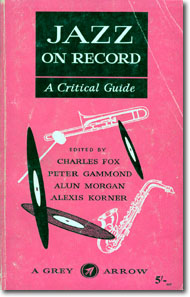 |
|||
| Chris Barber & Ken Colyer: A Critical View from 1960 |
|||
| The following reviews are scanned from Jazz On Record: A Critical Guide, by Charles Fox, Peter Gammond, Alun Morgan, and Alexis Korner, published in 1960. It's interesting to read these generally favourable perspectives from more than forty years ago, particularly as the British jazz snobs took over not long after that: neither Chris Barber nor Ken Colyer were deemed important enough to warrant their own entries in the next edition of the book, published in 1968. | |||
A thoroughly schooled and skillful musician, as a change from the traditionalists who play and lead bands after three months' payments on their instruments, Chris Barber is one of the best trombonists in England, and a fine bass-player, though not heard so frequently on this instrument. Sometimes he also breaks into song, but this is better forgotten. He found his true metier in the crisp-sounding band led by Ken Colyer in 1953 and which, soon after, became Chris Barber's own band. They were distinctive as being perhaps the first group to hit on what might be called an English style of jazz. It had little of the New Orleans tone about it but played in a style (especially noticeable on the ECHOES OF HARLEM LP) which came close to the California Ramblers bands of the '20S. There is no great depth to the music but the crisp, almost staccato sound, and the authoritative playing of Barber and Monty Sunshine, were combined to produce some pleasing and very successful jazz. As with most British groups the rhythm, particularly in slow numbers, is inclined to be plodding, with often weak bass playing and monotonously unenterprising drumming and banjo strumming. If only some of the leaders would spend as much time instructing their rhythm sections as they do their front-lines. It is a fitting place to make these few carping remarks because here is a band which is certainly as good as any white American band heard on record in the last few years and, except for its rhythm section, as good as many Negro bands. Moreover, the better the material selected, the better they play. Generally, however, there is not enough thought given to form (in this they should be compared to the Wilbur de Paris band which excels in creating shape and musical form) and a lot of performances, particularly the concert ones, end up as a rambling string of solos without any structure. These remarks are not only applicable to the Barber band. The 1954 recording on Decca started this band on its remarkable career. Here tracks like Bobby Shaftoe and The Martinique illustrate the strength of the band's ensemble playing and the advantages of some careful arrangements. Halcox at this stage was a little weak as a lead trumpet, a fault soon rectified, and with tracks like Merrydown rag and the commercially successful Rock Island Line, led by Lonnie Donegan, this LP (2) is a notable milestone in British jazz history. There is an excellent (apart from the vocal) It's tight like that on (4) and some delightful sides made at a Festival Hall concert on (5) with some of their best '20s-sounding efforts in I'd love it and a fine Skokiaan. The band was abetted here by Bertie King on alto. (9) introduced Ottilie Patterson to British audiences and they were captivated by this miniature Bessie Smith when she sang St. Louis blues and Reckless blues, still two of her best performances. The band fell into a smooth rut at times now but made some of their finest sides in the ECHOES OF HARLEM LP which are absolute gems of rejuvenated period jazz (11), and tracks like Doin' the crazy walk, Sweet Savannah Sue and Magnolia's wedding day are really enjoyable and accomplished sides. All three are on a fine EP, NJE1007, rightly called 'Chris Barber Special'. A series of LPs called Chris Barber in Concert are full of atmosphere and excitement but are apt to get monotonous because they degenerate into strings of solos which may have been fun on the night but sound pretty thin after couple of playings. Pat Halcox on these plays some confident and exciting music on sides like Bugle boy march (23) and the band is best where most arrangement is evident, as on Majorca (23), but dreadful where they give Ellington's Rockin' in rhythm (23) a Dixieland mauling. The Barber skiffle group without the ebullient Donegan is a disastrous affair. Copies are never as good as the original and, apart from their thin and callow efforts to sound happy, the tracks on an EP like (18) deserve the censure that would be given to a serious composer who modelled himself on Mozart or a novelist who tried to imitate Dickens today. They are doomed to failure from the start. Young Englishmen cannot sing Negro songs like Negroes, as is amply demonstrated in an EP like (26) where the band accompanies Sonny Terry and Brownie McGhee. The rhythm sparkles with the added power of these natural jazzmen. We cannot review all the Barber records individually but suggest that (28) is a very good sample of their present highly professional and still beautifully crisp playing. All the players have steadily improved and play with great confidence, and Ottilie Patterson's delightful piano and vocal performance on Squeeze me shows that her promise has been fulfilled. The band is wonderfully recorded here. |
|||
|
|||
KEN COLYER |
|||
| |
|||
